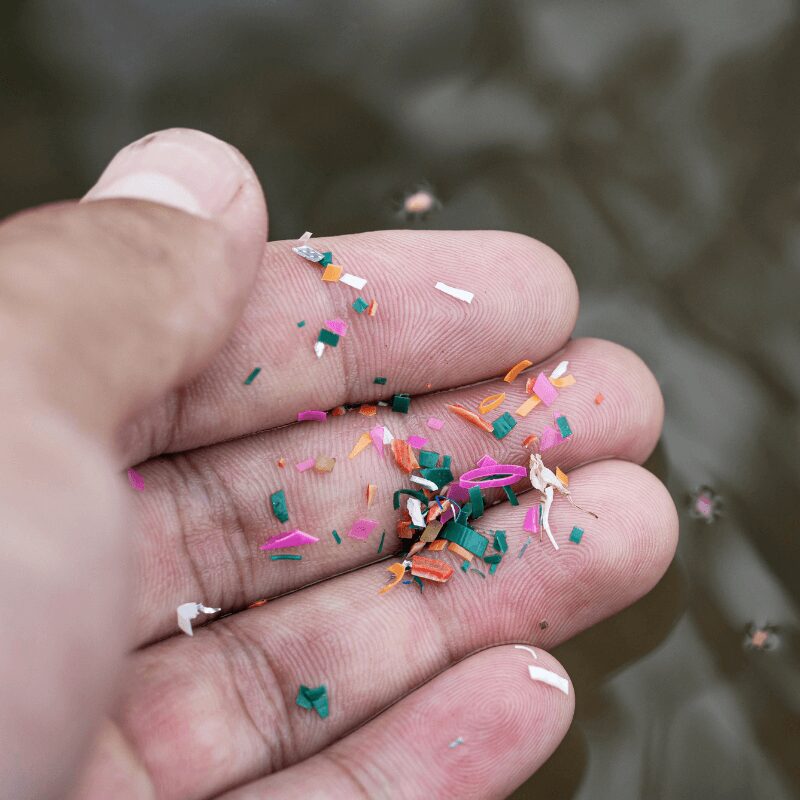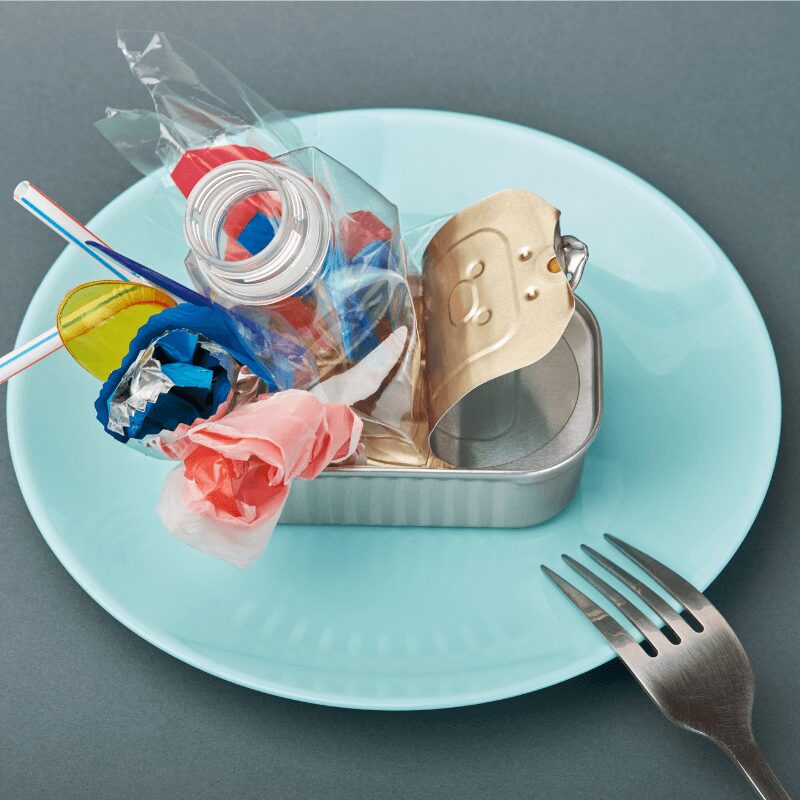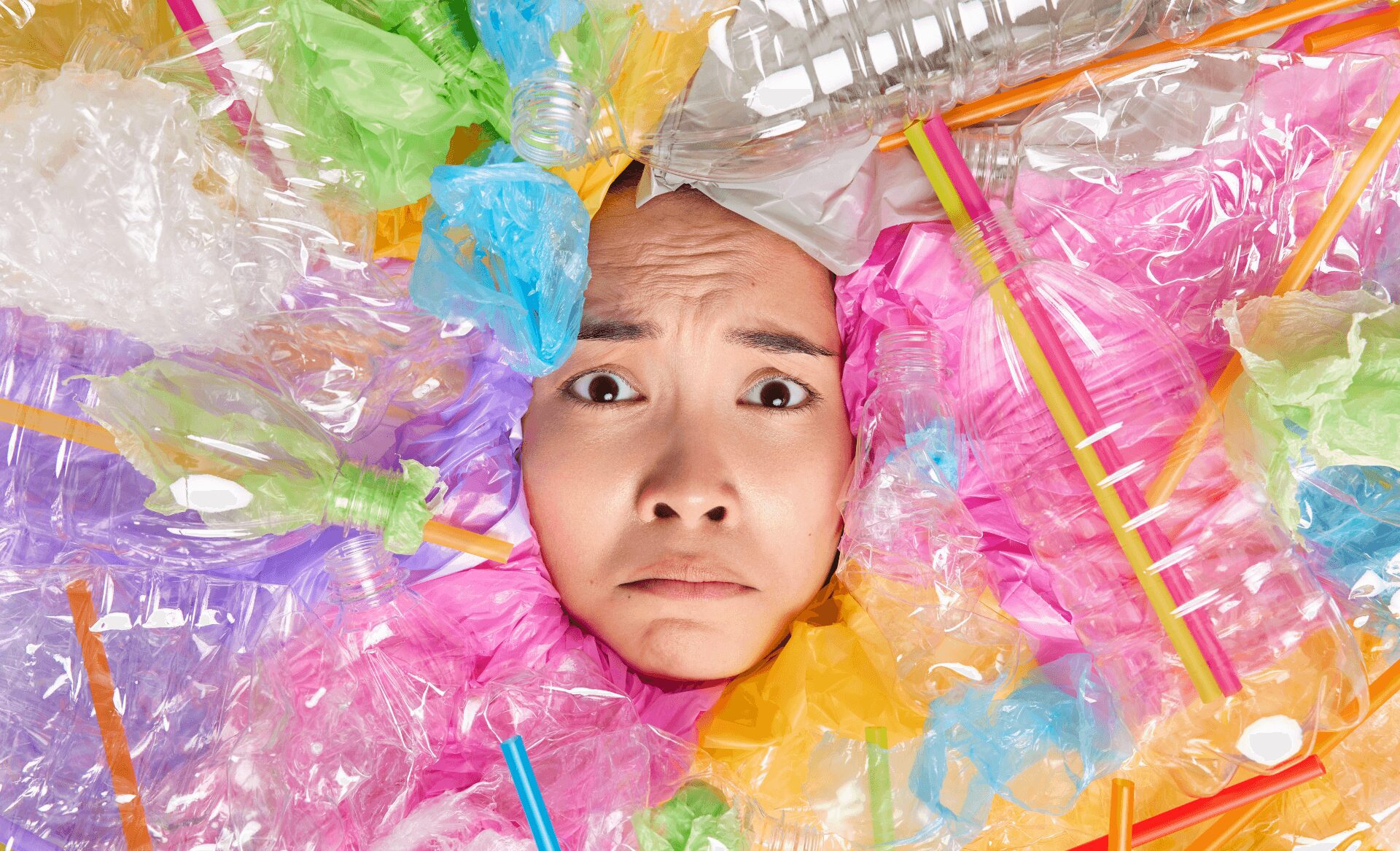(Hint: It’s Not Just Through Plastic Bottles)
Raise your hand if you’ve had plastic today.
No, not chewed on it. We mean actually consumed it—ate it, drank it, breathed it in.
You may not have done it willingly or knowingly, but it did happen.
Don’t believe us? Well, recent studies show that the average person ingests about a credit card’s worth of plastic every single week. That’s 5 grams a day, roughly 21 grams a month, or over 250 grams a year of tiny plastic particles called microplastics that are quietly sneaking into your system.
But the question is how?
How are we consuming plastic?
Where’s it coming from?
And what is it doing to our bodies?
The answers might surprise you. But don’t worry—there’s good news, too. Here at Bottleless Nation, we’ve done the research for you and are here to explain where this microplastic is coming from and how you can make some key lifestyle changes to help mitigate your plastic consumption.
Microplastics Explained
In order to understand the dangers of plastic consumption, we feel it’s necessary to first explain what form it takes. We know you’re not sitting there chewing on a plastic milk jug. Instead, we’re talking about the microscopic pieces of plastic, or what we commonly refer to as microplastics.
Microplastics are plastic particles under 5 millimeters in size and come from the breakdown of larger plastic items, like plastic bottles and jugs, bags, straws, utensils, and containers. Unfortunately, a majority of this plastic ends up either in our landfills or our oceans. And over time, sunlight, heat, and nature’s friction break them down into microscopic bits that drift into our food, water, and air.
While they seemed relatively harmless for decades, these particles are building up in our oceans, on land, and in the air.
Plastic’s Not Just Around Us, It’s In Us
We get it…plastic is everywhere. It’s cheap, it’s easy, and it feels harmless in the moment. One bottle here, a takeout container there. What’s the big deal, right? But here’s the thing: every time we reach for single-use plastic, especially bottles and jugs, we’re not just contributing to landfill waste or ocean pollution; we’re inviting microplastics into our bodies.
And they don’t just pass through us unnoticed. Scientists have found microplastics in human blood, lungs, breast milk, and even the placenta. Unfortunately, these early studies are now linking microplastic exposure to chronic inflammation, which is your body’s way of sounding the alarm. But unlike a short-term illness, this kind of inflammation doesn’t turn off, and over time, it can wear your system down.
Hormonal disruption is another big red flag of plastic consumption. Plastics can interfere with how our bodies regulate everything from metabolism to fertility, and those imbalances don’t fix themselves overnight.
Then there’s the gut. Your microbiome is like mission control for your immune system, digestion, and mood. When microplastics disrupt the ecosystem, things get out of sync quickly. And if that wasn’t enough, researchers are beginning to explore connections between microplastic accumulation and more serious conditions like cancer, cardiovascular disease, and even neurodegenerative disorders.
So yeah, that “grab-and-go” bottle might cost a couple bucks. But the long-term toll? That’s paid out in ways we’re only starting to understand.
How Are We Actually Consuming Plastic?
While you may not prefer a side of plastic with your steak dinner, it’s unfortunately making its way into your diet no matter what, and it’s entering through a few key sources, some obvious, some sneaky.
1. Water (Yes, Especially Bottled)
If you’re still drinking bottled water thinking it’s safer, we hate to burst your bottle, but it’s one of the biggest sources of microplastics in your daily life.

Studies show that bottled water can contain up to 240,000 microplastic particles per liter. That’s more than twice what’s found in most tap water.
The plastic packaging leaches into the water during transport and storage, especially when bottles are exposed to heat. And those tiny particles? You’re sipping them right down.
2. Food
Seafood is a major culprit—fish and shellfish ingest microplastics floating in the ocean, and when we eat them, we’re getting a serving of plastic, too. But it doesn’t stop there.
Microplastics have also been found in:
- Salt
- Sugar
- Fruits and vegetables
- Processed foods
- Food wrapped or stored in plastic containers
It’s a full-course meal… with a plastic garnish.
3. Air
Believe it or not, you’re probably inhaling microplastics as you read this. Indoor air, especially in spaces filled with plastic packaging, synthetic fabrics, and worn-down household items, can contain plastic dust and fibers.
That dust floats, settles, and gets kicked back up again. You breathe it in, and into your lungs it goes.
4. Plastic Products & Packaging
Plastic containers, cling wrap, and disposable drink lids are part of everyday routines, but they come with hidden risks. When plastic is heated, whether in the microwave or from holding hot liquids, it can release tiny particles into food and beverages. These microplastics aren’t visible, but they’re being ingested all the same.
Even plastics marketed as “safe” alternatives can break down under heat, leaching synthetic compounds into whatever you’re eating or drinking. Over time, these exposures add up. Choosing non-plastic options for food storage and drinkware is one of the most effective ways to reduce daily plastic intake—and it’s a switch that benefits both personal health and the environment.
Simple Ways to Cut Back on Plastic (That Actually Make a Difference)
Reducing plastic use doesn’t have to mean overhauling your life. A few thoughtful shifts in your daily habits can go a long way, especially when those choices become consistent.
1. Swap Bottled Water for Bottleless Solutions
This one’s kind of our thing and for good reason. Bottled water is one of the biggest contributors to single-use plastic waste. Switching to a bottleless water system in the office is an easy win. It reduces plastic waste, cuts costs, and eliminates the risk of microplastics leaching into your water. It’s cleaner, more sustainable, and way less of a hassle than hauling cases of bottles or swapping out jugs every week.
2. Rethink How You Store and Reheat Food
Plastic containers might be convenient, but they’re not doing your body (or the planet) any favors. When heated, they can shed microplastics into your meals. Replacing plastic with glass, stainless steel, or silicone options can dramatically reduce your exposure. It’s a one-time switch that pays off every time you use it.
3. Be Intentional with Packaging
From groceries to takeout, packaging adds up fast. Look for products with minimal or compostable packaging, and bring your own bags or containers when possible. Even small shifts—like choosing the loose produce over pre-bagged—can add up over time. The more mindful we are about what we’re bringing into our homes and businesses, the easier it becomes to cut plastic out of the equation.
Reducing your plastic footprint doesn’t have to be all or nothing. Start with one habit, build from there, and keep moving forward. Every change matters—especially when it’s multiplied by a community committed to doing better.

How Bottleless Nation Helps You Break the Cycle
Bottleless Nation was founded on a simple belief:
To eliminate as many plastic bottles and jugs from circulation as possible in hopes of becoming One Bottleless Nation, and that all starts by being aware of where our drinking water comes from.
We’re not a water supplier. We’re a movement. We connect businesses and organizations with sustainable, bottleless water solutions through our trusted partners like Artesian Bottleless Water and Office H2O.
By switching from plastic bottles and jugs to modern, filtration-based water dispensers, you:
- Eliminate a major source of microplastics in your daily life
- Reduce single-use plastic waste at home or in your business
- Save money in the long run (no more bulk water deliveries or stacks of jugs)
- Protect your health, your team, and the planet
It’s one of the easiest changes you can make with the biggest ripple effect.
This Isn’t About Perfection—It’s About Momentum
The truth is, we’re all navigating a world that wasn’t built with sustainability in mind. But that doesn’t mean we’re stuck. Every plastic bottle you skip, every reusable swap you make, every refill from a bottleless system—it all adds up. Not just in your home or workplace, but in the collective impact we create when we stop treating plastic as the default.
At Bottleless Nation, we’re here to help make that shift easier, more accessible, and more effective. Because when people are informed, supported, and equipped with better options, they make better choices for their health, for their families, and for the environment.
You don’t have to overhaul everything overnight. You just have to start.
Together, we can improve our planet and become One Bottleless Nation.

